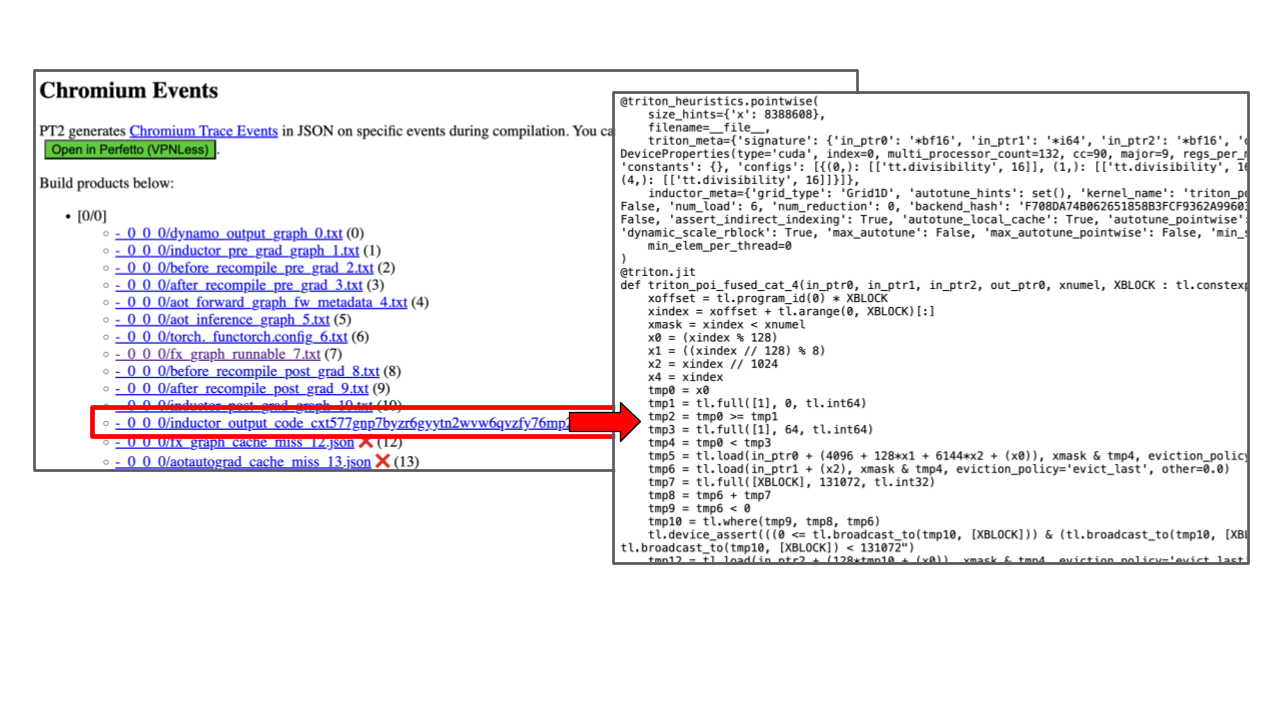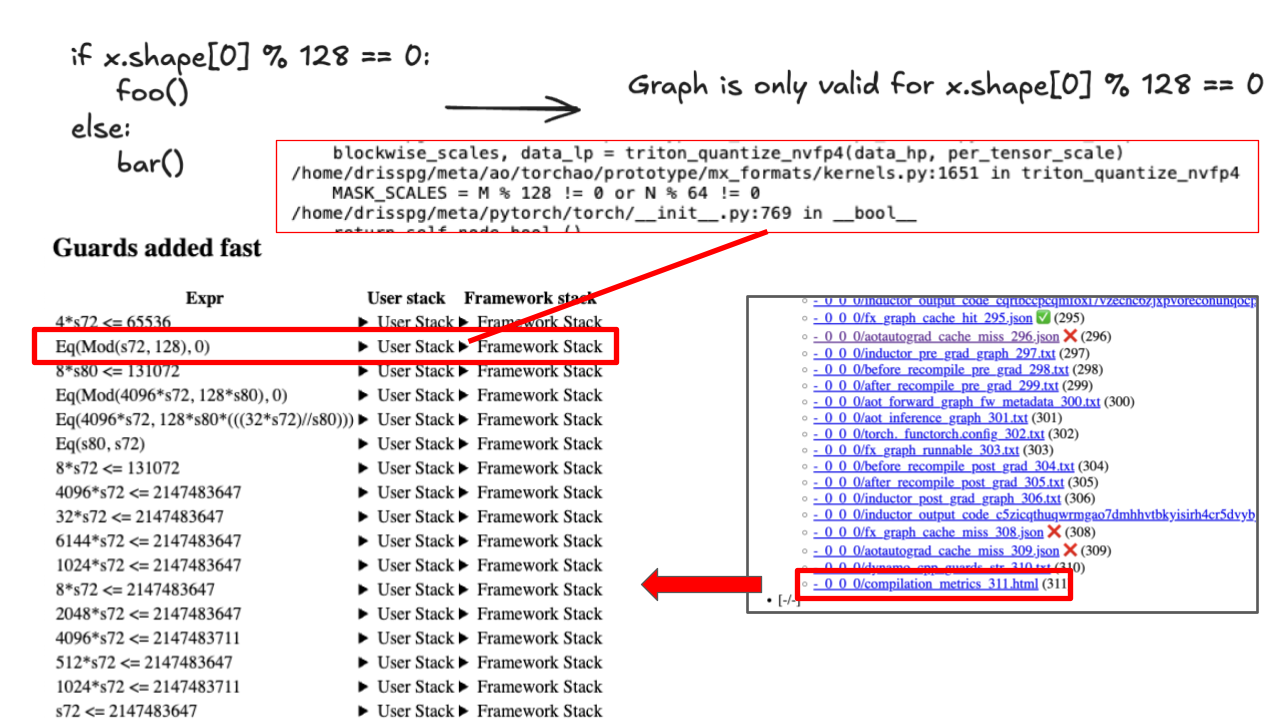How to debug the vLLM-torch.compile integration¶
TL;DR:
- use tlparse to acquire torch.compile logs. Include these logs in bug reports and/or support asks.
- The vLLM-torch.compile integration is multiple pieces. vLLM exposes flags to turn off each piece:
| Online Flag | Offline Flag | Result |
|---|---|---|
| --enforce-eager | enforce_eager=True | Turn off torch.compile and CUDAGraphs |
| -O.mode=0 | mode=CompilationMode.NONE | Turn off torch.compile only |
| -O.cudagraph_mode=NONE | compilation_config=CompilationConfig(mode=CompilationMode.NONE) | Turn off CUDAGraphs only |
| -O.backend=eager | compilation_config=CompilationConfig(backend='eager') | Turn off TorchInductor |
vLLM-torch.compile overview¶
To improve performance, vLLM leverages torch.compile and CUDAGraphs to speed things up. torch.compile generates optimized kernels for PyTorch code while CUDAGraphs eliminates overhead. Most notably, vLLM-compile is NOT torch.compile, it is a custom compiler built using internal PyTorch Compile APIs.
- Given a model, we do a full graph capture via TorchDynamo that is dynamic on the batch size (number of tokens)
- vLLM then optionally splits and/or specializes this graph and then uses TorchInductor to compile each graph into a compiled artifact. This step may use vLLM custom Inductor passes to further optimize the graph.
- The compiled artifact is saved to vLLM's compile cache so that it can be loaded in the future.
- vLLM applies CUDAGraphs to reduce CPU overheads.
Things can go wrong in each of the four steps. When something does go wrong, please try to isolate the subsystem that went wrong -- this will allow you to turn off the minimal number of things to keep reliability goals while minimizing impact to performance and also helps us (vLLM) when you open a bug report.
For more details on the design, please see the following resources:
- Introduction to vLLM-torch.compile blogpost
- vLLM-torch.compile integration design
- vLLM Office Hours #26
- Talk at PyTorch Conference 2025
Use tlparse¶
Use tlparse to acquire torch.compile logs. These logs show all stages of the compilation process, including the fused kernels that torch.compile produces. If you can, we recommend sending these or pieces of these along with any bug reports -- they are very helpful.
Install tlparse:
Usage (offline inference)
Usage (serving)
TORCH_TRACE=~/trace_dir vllm serve
# ctrl-c out of the server
tlparse ~/trace_dir/<the_first_log_file>
The tlparse command outputs some HTML files (perhaps into e.g. ./tl_out/index.html). Open it to see the logs. It'll look something like the following:
Turn off vLLM-torch.compile integration¶
Pass --enforce-eager to turn off the vLLM-torch.compile integration and run entirely in eager mode. This includes turning off CUDAGraphs.
To turn off just torch.compile, pass mode = NONE to the compilation config. (-O is short for --compilation_config):
# Offline
from vllm.config.compilation import CompilationConfig, CompilationMode
LLM(model, compilation_config=CompilationConfig(mode=CompilationMode.NONE))
To turn off just CUDAGraphs, pass cudagraph_mode = NONE:
# Offline
from vllm.config.compilation import CompilationConfig, CUDAGraphMode
LLM(model, compilation_config=CompilationConfig(cudagraph_mode=CUDAGraphMode.NONE))
Debugging TorchDynamo¶
vLLM requires model code be capturable into a full graph via TorchDynamo (torch.compile's frontend). TorchDynamo does not support all of Python. It will error (in fullgraph mode) if it cannot support a feature (this is sometimes known as a graph break).
If you encounter a graph break, please open an issue to pytorch/pytorch so the PyTorch devs can prioritize. Then, try your best to rewrite the code to avoid the graph break. For more information, see this Dynamo guide.
Debugging Dynamic Shape full graph capture¶
vLLM requires that the model's forward pass be capturable into a full graph that is dynamic on the batch size (i.e. the number of tokens). It (by default) compiles this one graph into one artifact and uses this artifact for all batch sizes.
If your code cannot be captured with Dynamic Shapes, you may see silent incorrectness, loud errors, or CUDA illegal memory accesses. For example, the following is not capturable into a single graph:
This problem is easy to diagnose. Use tlparse and click on compilation_metrics: it will tell you symbolic constraints on the batch size. If there is any constraint that restricts the batch sizes, then we've got a problem.
To avoid this, please either:
- avoid branching on the number of tokens
- wrap the branching logic into a custom operator. TorchDynamo does not trace into custom operators.
Debugging TorchInductor¶
TorchInductor takes a captured graph and then compiles it down to some Python code that may call 1+ triton kernels. On rare (but unfortunate) occasions, it may produce an incorrect triton kernel. This may manifest as silent incorrectness, CUDA illegal memory accesses, or loud errors.
To debug if TorchInductor is at fault, you can disable it by passing backend='eager' to the compilation config:
If Inductor is at fault, file a bug to PyTorch. If you're feeling adventurous, you can debug the triton kernels in the Inductor output code (that you can locate via using tlparse).
You can also use TORCH_LOGS=output_code <command> to print the Inductor output code.
Editable TorchInductor code¶
You can edit the TorchInductor code that gets run by setting VLLM_COMPILE_CACHE_SAVE_FORMAT=unpacked or passing -O.compile_cache_save_format=unpacked. The default is binary, which means it is not editable.
This is a useful technique: you can put breakpoints (e.g. torch.distributed.breakpoint()) and print statements in the output code.
Debugging vLLM-compile cache¶
vLLM built its own cache for torch.compile artifacts. The idea is that the artifacts can be compiled once and then reused after they have been compiled. This is a layer on top of torch.compile's compiler cache.
While torch.compile's compiler cache is rock-stable, vLLM's compiler cache is unfortunately not always correct. You can disable it via setting VLLM_DISABLE_COMPILE_CACHE=1.
You can also manually remove this cache.
- Remove vLLM's compile cache with
rm -rf ~/.cache/vllm(look at logs to see if the location changed) - Remove torch.compile's built-in caches with
rm -rf /tmp/torchinductor_$(whoami)
vLLM's cache is a mapping from cache key to a compiled artifact. vLLM computes the cache key via combining multiple factors (e.g. config flags and model name). If vLLM's compile cache is wrong, this usually means that a factor is missing. Please see this example of how vLLM computes part of the cache key.
Debugging CUDAGraphs¶
CUDAGraphs is a feature that allows one to:
- Capture a callable that launches 1+ CUDA kernels into a CUDAGraph
- Replay the CUDAGraph
The captured CUDAGraph contains all of the memory used during the capture process. The replay of the CUDAGraph reads and writes to exactly the same regions of memory.
This leads to some restrictions:
- In order to use CUDAGraphs on new data, you'll need to copy the data into a buffer that the CUDAGraph is reading from
- CUDAGraphs only capture CUDA kernels, they don't capture work done on CPU.
vLLM uses the raw CUDAGraphs API, which is unsafe when used incorrectly.
To turn off just CUDAGraphs, pass cudagraph_mode = NONE:


